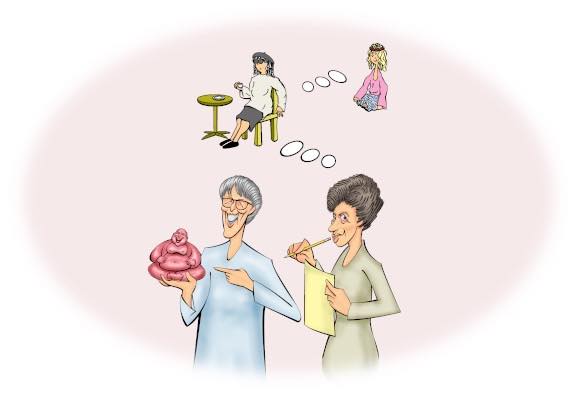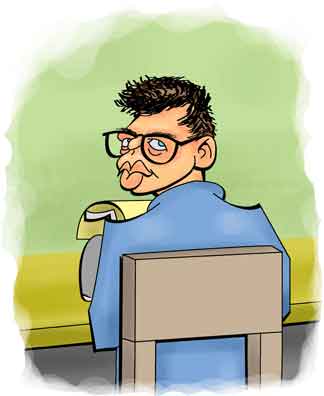Joanne Kyger
and
Diane di Prima

Joanne and Diane
(Click to Zoom In and Out)
| To consider the Beat phenomenon ... it was this group of Columbia guys, Burroughs, Kerouc, Ginsberg, who were hanging out together. |
| - | Joanne Kyger, 2000 |
| |
| Some of us sold out and became hippies. |
| - | Diane Di Prima, 1969 |
It's scarcely news now, but Joanne was correct. The famous "Beat Generation" was largely driven by the guys from Columbia, Allen Ginsberg, Jack Kerouac, and William Burroughs. It was only later that the women writers began to achieve due recognition.
Joanne and Dianne were primarily poets. Diane's first major book, This Kind of Bird Flies Backward was published in 1958. But she had been actively involved in the literary scene long before and had been the co-editor of the magazine The Floating Bear with Leroi Jones (who later took the name Amiri Baraka). Over the years Diane published Dinners and Nightmares, The New Handbook of Heaven, Poets' Vaudeville, Seven Love Poems from the Middle Latin, Haiku, New Mexico Poem, Earthsong, Hotel Albert, L. A. Odyssey, The Book of Hours, Revolutionary Letters, The Calculus of Variation, Loba, Freddie Poems, Selected Poems: 1956-1975, The Mysteries of Vision, Pieces of a Song: Selected Poems, Seminary Poems, The Mask is the Path of the Star, Recollections of My Life as a Woman: The New York Years, Fun with Forms, Towers Down (with Clive Matson), The Ones I Used to Laugh With, and TimeBomb.
Joanne had been writing poetry since she was a kid and when she was twenty she went to Japan. It wasn't until she returned to San Francisco in 1964 that she was able to publish her first book of poetry, The Tapestry and the Web. Over the years she published Joanne, Places To Go, All This Every Day, Lettre de Paris, The Wonderful Focus of You, Up My Coast, Going On, Man/Woman (with Michael Rothenberg), Phenomenological, Just Space, Some Sketches from the Life of Helena Petrovna Blavatsky, Patzcuaro, Some Life, Again: Poems (1989-2000), As Ever: Selected Poems, Ten Shines, The Distressed Look, God Never Dies, Detektivgeschichten Der Leidenschaft (with Stefan Hyner), Night Palace, About Now: Collected Poems, Not Veracruz, and Lo & Behold: Household and Threshold on California’s North Coast.
Although Joanne is sometime referred to as a Beat poet, she has pointed out that the San Francisco literary scene of the late 50's and 60's was not simply the New York City beatniks moving to the West Coast. Certainly the Beats - including Diane - started off in New York and relocated to San Francisco.
But Joanne was a native Californian and after attending college in Santa Barbara she moved to San Francisco. There she met the literary group that had been congregating around Berkeley since the late 1940's. This counterculture literary movement is now called the San Francisco Renaissance and although they were closely tied to and overlapped with the Beats, they are not exactly the same thing.
One thing that makes it hard for a lot of people to "dig" the Beat literature is it formed from modernistic poetry - certainly not everybody's cup of espresso. So sometimes the best introduction to the Beat writers is not their most typical oeuvre. For instance, before reading William Burrough's Naked Lunch, you might try his Yage Letters first.
And today one of Joanne's most popular books is the journal she kept when traveling through Japan and India1. Now titled Big Strange Moon, it will appeal to even the most traditional readers who enjoy personal narratives.
The excerpts here are all included for commentary and review.
August 10, 1960
Bus to Okiiinja, Shinto Shrine for this island. Walk back, swim from fisherman's shack, two hour boat ride to main island's port of Saigo. Vets and Gary and I go out after dinner and bath at ryokan2 (which looks like cheap southern California motel) to look for workingman's bar to hear island songs. Instead end up getting entertained by loud laughing geisha and handing out 11000 yen3.
A ryokan (旅館 in Chinese characters, りょかん in Kana script) is a traditional Japanese inn found particularly in hot springs resorts. You usually sleep on a folding mattress, the futon.
A bit more than $100 at the time and now about $485.
If you try to calculate the current value just using the Consumer Price Index, you'll likely get a higher value. But that's because the yen and dollar have not changed value at the same rate.
Diane's Memoirs of a Beatnik was published in 1969 and seems to be her most popular book. But some reviewers have cautioned about taking it as a journalistic description of what it was like to be a beatnik4. It seems that the publisher and editors - they were men, remember - kept sending the manuscript back asking for more steamy scenes. From the book you wonder when the beatniks found time (or the strength) to eat5.
Of course, Bullwinkle's "Mr. Know-It-All's" advice on "How To Be a Beatnik" is not to be taken literally either.
Diane's own assessment was that the book was mostly accurate, "except for the sex parts".
Other Beat poets have published prose. So when starting to read the writings of Allen Ginsberg you can try his Indian Journals which covers his time in the eastern subcontinent from 1962 to 1963:
O Elephant Head God Ganipati, appear & disappear for an instant in the mind before I begin to understand the Poem come save me with your Ray - Better late than never!

Allen Ginsburg
You might want to try Joanne and Diane's books first.
Hm. Maybe you should start off with Joanne's and Diane's books6.
Lest Allen's fans go into spittle flinging diatribes at what may be taken as a dismissal of his works, it is generally acknowledged that the beginning of his magnum poema HOWL are among the best opening lines of a poem ever penned.
The rise and eventual close of the Beat Generation is pretty well documented. They arose in the late 1940's and by 1952 had already been dubbed "The Beat Generation" by writer John Clellon Holmes. But it wasn't until 1956 that Allen Ginsberg's book HOWL and Other Poems hit the bookstores. Jack Kerouac's On the Road was published in 1957 and in 1958 the word "beatnik" was finally coined.
Diane was pretty much correct when she spoke of what happened to the "beatniks". Despite it's somewhat condescending tone, the word did acquire colloquial use even among the Beats themselves and Joanne would use the word in letters to her friends. And we saw that Diane even named her most popular book Memoirs of a Beatnik although like as not the title was an editorial selection.
And yes, the Beats were the direct precursors to the famous 1960's San Francisco hippies, and the early hippies actually retained the nik-name7 longer than most people realize. Today the "Summer of Love" of 1967 can be considered the crest of the hippie movement. Or at least it was before hippies went mainstream with the Broadway musical Hair the following year and the adoption of flower power pastel set designs on network quiz programs during the 1970's.
"Beatnik" is sometimes considered the first use in English of adding the -nik suffix to a group of people who follow a popular trend. It was taken from the name of the Russian satellite Sputnik - often translated as "Fellow Traveller" - which had been launched in 1957. Use of the "nik" addition before then is obscured by it being part of Yiddish and Slavic languages.
But in October of 1966 "The Pop Art Affair" episode of The Man From UNCLE uses the word "beatnik" for what are clearly hippies8. And as late as February of 1967 - that's 1967 - none other than Hunter S. Thompson - yes, Hunter S. Thompson - used the word "beatnik" to describe the inhabitants of the Haight-Ashbury neighborhood of San Francisco. It wasn't until the next month that the famous column by Loudon Wainright appeared in Life Magazine and announced the hour of the "hippies" was coming9,10.
The Pop Art Affair is not, we must admit, the most stellar example of that popular TV show. Napoleon and Illya were trying to capture a villain named Mark Olé who was (of course) a member of the evil international criminal organization THRUSH. Olé was getting rid of his enemies by exposing them to a gas that caused - get this - fatal hiccups. Of course like any good THRUSH villain, he had to have a cover. So he doubled as a Greenwich village art dealer who sold pop-art created by - the word used in the script - the local "beatniks".
Now although there were some Beat elements written into the script (espresso, jazz, poetry readings), from their apparel and hair styles - not to mention the references to the generation gap and the "happenings" - most of the young people that Napoleon and Illya met were clearly hippies. But the word was never used.
As one reviewer pointed out, the writers for The Man From UNCLE had difficulty depicting young people. In particular those from the counterculture usually came out as rather weak parodies. Illya's attempts to "talk beatnik" in the coffee shop are unintentionally hilarious.
Loudon also stated the lifestyle couldn't last and he was correct. By the fall of 1967 the owner of one of the psychedelic shops said that business had fallen off to the point where he was going to close. People who came to the Bay Area hoping to find the happy, smiling flower children of legend instead encountered burned out kids with glazed eyes and vacuous expressions. Crime rates had skyrocketed, and by the time the sixties faded, Haight-Ashbury was nothing more than a typical big city skid row. It wasn't until the 1980's that the street had revitalized and became more visitor friendly with clothes shops and lunch spots suitable for the tourist.
The actual use of "hippie" in the modern sense starts up suddenly in 1967. Of course, the word does show up before then in different contexts. For instance, one reference to "hippies" in the early 20th century referred to small hippopotamus. "Hippie" is also a surname and the transliteration of the Greek word Ἱππίας is sometimes transcribed as "hippies".
Sadly, like most of the original Beats, neither Joanne or Diane are with us. Joanne died in November, 2017 and Diane in October, 2020.
References and Further Reading
Memoirs of a Beatnik, Diane di Prima, Olympia Press, 1969.
"Joanne Kyger", Poetry Foundation.
"Diane Di Prima", Poetry Foundation.
Minor Characters, Joyce Johnson, Houghton Mifflin, 1983.
"Particularizing People's Lives: Joanne Kyger in Conversation with Linda Russo", Linda Russo, Jacket Magazine, 2000.
Loba, Diane Di Prima, Capra Press, 1973.
Big Strange Moon: The Japan and Indian Journals, Joanne Kyger, North Atlantic Books, 2000.
Joanne Kyger", Electronic Poetry Center, University of Pennsylvania.
"Female Beat Writers To Read Instead Of Kerouac", Shaun Fitzpatrick, Bustle,
March 10, 2017.
"Diane di Prima, Beat Poet And Activist", Andrew Limbong, The Guardian, October 27, 2020.
"Ryokan", Japanese Guide.
"The Strange New Love Land of the Hippies", Loudan Wainwright, The View from Here, Life Magazine, March 31, 1967, pp. 15-16.
The Man From U.N.C.L.E. Episode Guide, Bill Koenig.
"The Pop Art Affair", Robert Vaughn (actor), David McCallum, (actor), Leo G. Carroll (actor), Sherry Alberoni (guest actor), Sabrina Scharf (guest actor), Robert H. Harris (guest actor), George Waggner (director), Al Ramrus (writer), John Shaner (writer), MGM, NBC, October 21, 1966.
"This Is The Beat Generation", John Clellon Holmes, The New York Times Magazine, November 16, 1952.
"How Herb Caen Named a Generation", Jesse Hamlin, SF Gate, November 26, 1995.
"How To Be a Beatnik", Mr. Know-It-All, Metal Munching Mice, The Adventures of Rocky and Bullwinkle and Friends, November 17, 1961 .
"Hippie, Hippies, Beatnik, Beatniks", Ngram Viewer.
Return to CooperToons Caricatures
Return to CooperToons Homepage

